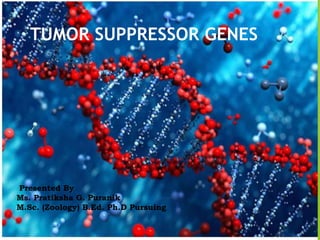
Tumor suppressor gene
- 1. TUMOR SUPPRESSOR GENES Presented By Ms. Pratiksha G. Puranik M.Sc. (Zoology) B.Ed. Ph.D Pursuing
- 2. Content Introduction 1. The retinoblastoma tumor suppressor gene. 2. The Tp53 tumor suppressor gene. 3. pAPC tumor suppressor gene. 4. pBRAC1 and pBRAC2 tumor suppressor gene. References.
- 3. Introduction • Occasionally, dividing and differentiating cell deviate from their normal genetic program and give rise to tissue masses called tumors. • Normal cell contained gene product that have the ability to suppress uncontrolled cell proliferation characteristics of cancer cell is termed as tumor suppressor gene.
- 4. 1. Retinoblastoma tumor suppressor gene • The RB gene was cloned in 1986. It spans 180 kb of DNA and encodes 4.7-kb mRNA that is translated to produce the 928-amino acid nuclear phosphoprotein, pRB. • pRB is involved in regulating the cell cycle at the G1-to-S checkpoint. • pRB is found in a complex with transcription factor E2F and, when pRB is unphosphorylated, the activity of E2F is inhibited. • Then, when pRB becomes phosphorylated, the inhibition of E2F activity is removed and the now-active transcription factor turns on the transcription of genes for DNA synthesis.
- 5. • Retinoblastoma develops during the period from birth to age 4 years and is the most common eye tumor in children. • By laser therapy or by radiation therapy more than 90% of the eye tumors can be permanently destroyed. • There are two forms of retinoblastoma: In sporadic retinoblastoma (60% of cases) and In hereditary retinoblastoma (40% of cases). • Retinoblastoma is a cancer caused by two mutational events, One mutation is inherited the germinal cells and the second occurs in somatic cells. • Knudson’s two-hit mutational model, as exemplified by retinoblastoma.
- 6. Fig: Knudson’s two-hit mutation model for familial cancer
- 7. Fig :Role of pRB in regulating the cell cycle at the G1-to-S checkpoint
- 8. Fig. A case of retinoblastoma
- 9. 2. The TP53 Tumor Suppressor Gene. • The tumor suppressor gene TP53 encodes a protein of molecular weight 53 kDa called p53. • When both alleles are mutated, TP53 may be involved in the development of perhaps 50% of all human cancers, including breast, brain, liver, lung, colorectal, bladder, and blood cancers. • Function of p53. The 393-amino acid p53 tumor suppressor protein is a transcription factor that is regulated by phosphorylation and by its interaction with another phosphoprotein, the negative regulator Mdm2.
- 10. • In a normal cell, both proteins are unphosphorylated, which allows them to bind together. • Mdm2 stimulates degradation of p53, and as a result, the amount of p53 in the cell is low. • When DNA damage occurs, p53 initiates a cascade of events leading to arrest in .
- 11. Fig : Function of p53 in cell cycle control
- 12. 3. pAPC • The 310-kilodalton pAPC protein was discovered through the study of adenomatous polyposis coli, an inherited condition that often leads to colorectal cancer. • This large protein, plays a key role in regulating the renewal of cells in the lining, or epithelium, of the large intestine. • pAPC controls the proliferation and differentiation of cells in the epithelium of the intestine. • When pAPC function is lost, the cells that generate the finger like projections on the intestinal epithelium remain in an undifferentiated state.
- 13. Fig : APC gene
- 14. 4. pBRCA1 and pBRCA2 • BRCA1 was mapped to chromosome 17 in 1990 and isolated in 1994. • And BRCA2 was mapped to chromosome 13 in 1994 and isolated in 1995. • Both pBRCA1 and pBRCA2 carry out important function within the cells. • Mutation in both the genes account for about 7 percent of all the case in breast cancer and 10 percent in ovarian cancer.
- 16. Fig: Functions of BRCA1
- 17. References: 1. Snustad P.D, Simmons J.M., Principles of Genetics 6th Edition. 2. Russel J.P. iGenetics A molecular Approach 3rd edition. 3. https://www.google.com/search?q=brca1+and+brca2+mutations 4. https://www.google.com/search?q=brca1+and+brca2+function